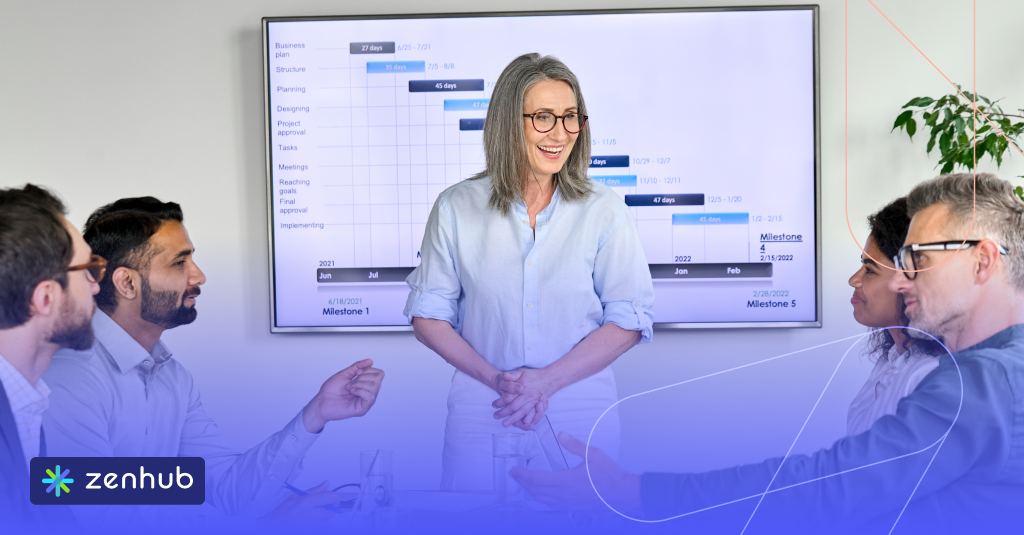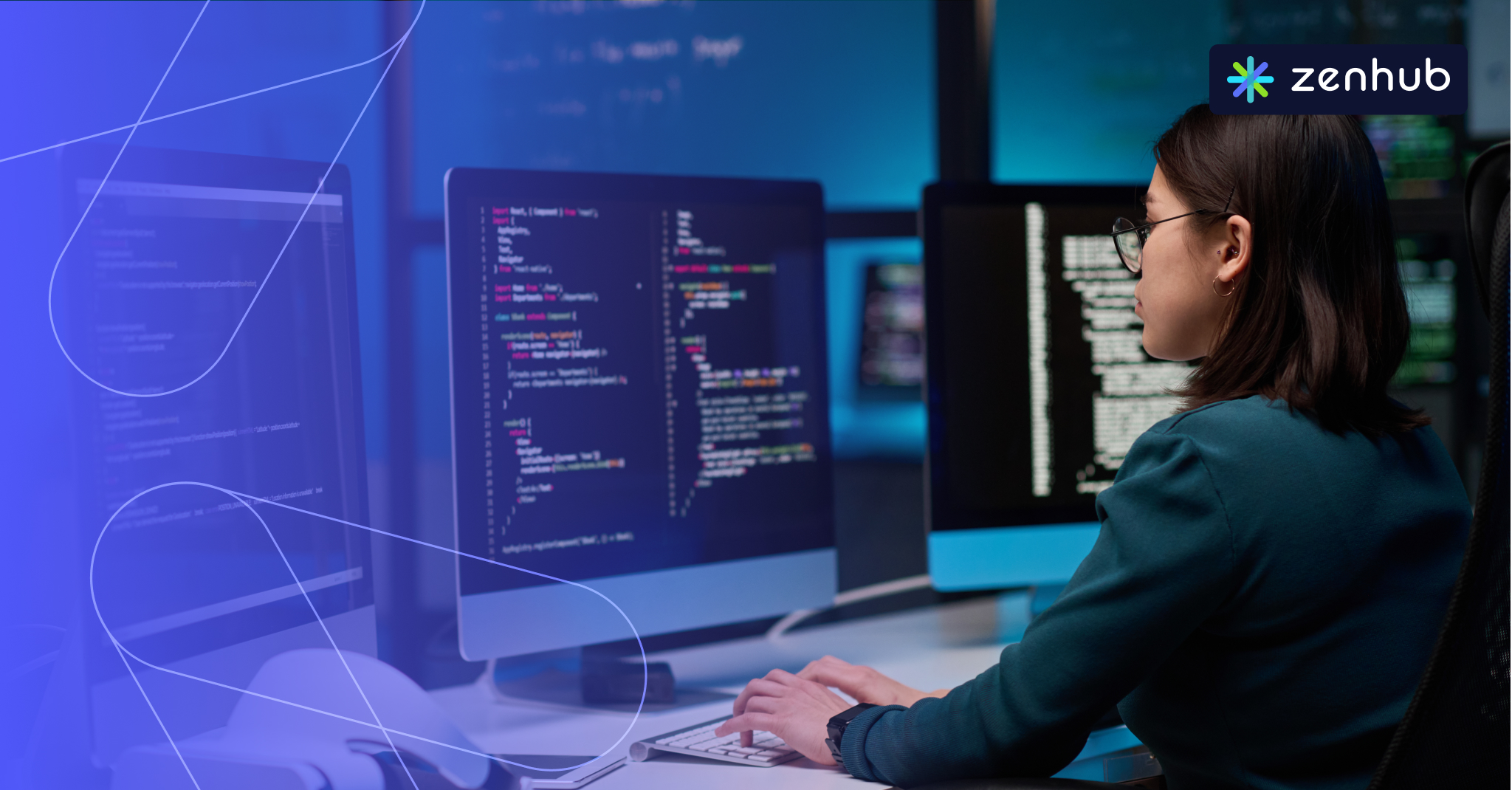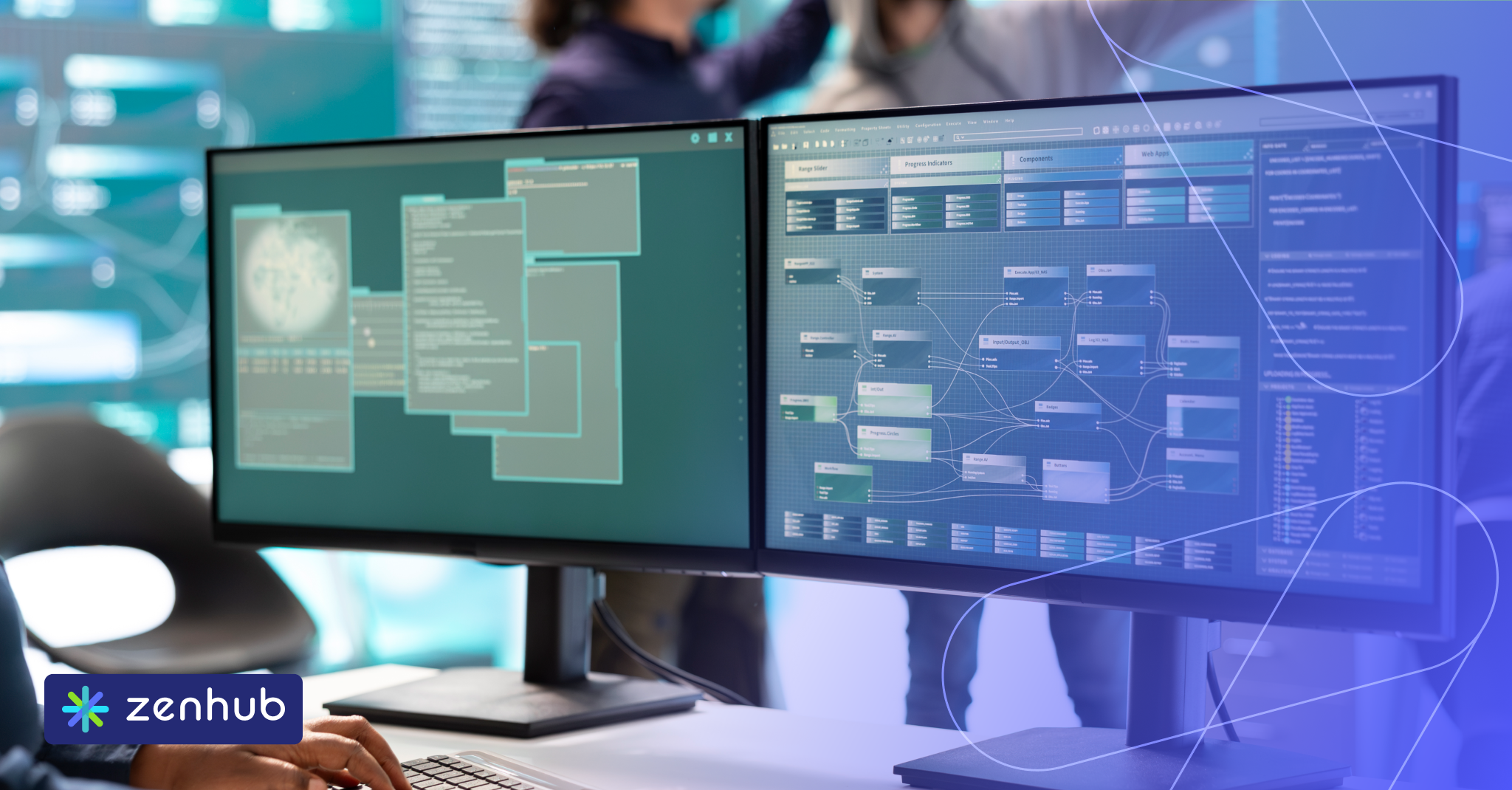Browse topics
Project management is constantly changing as AI and automation capabilities mature beyond simple automation into intelligent workflow optimization. With 91% of project managers expecting AI to significantly alter their role, teams that embrace AI project management today will define tomorrow's standards for efficiency and predictable delivery. In this guide, we’re going to walk through some techniques and workflows you can use to integrate AI into your project management practices. Using these techniques, PMs can keep their projects on track more predictably and bring more consistency to their teams.
Why AI and Automation in Project Management Matters
Integrating AI and automation into project management signifies a shift from reactive coordination to proactive intelligence. This transformation becomes even more powerful for software teams working within GitHub workflows through GitHub-native solutions. Unlike traditional project management tools that require separate logins and constant data synchronization, GitHub-native platforms embed planning, tracking, and reporting directly inside GitHub's interface, where developers already work.
Rising failure rates and the cost of manual PM
Project failure rates continue to climb, with manual processes bearing much of the blame. Consider these sobering metrics:
- Average project overrun: 27% over budget and 49% late, according to recent studies
- Developer time spent on administrative tasks: 23% of total working hours
- Cost of context-switching: Up to 40% productivity loss when switching between tools
Gartner predicts that 80% of project management tasks will be AI-driven by 2030, fundamentally changing how teams collaborate and deliver. This prediction isn't about replacing project managers but eliminating repetitive tasks that consume valuable time and introduce human error.
How GitHub activity fuels smarter predictions
GitHub repositories contain a goldmine of project intelligence waiting to be unlocked. Every commit, issue update, and pull request tells a story about team velocity, bottlenecks, and delivery patterns. AI project management tools like Zenhub AI transform this raw data into actionable insights through sophisticated pattern recognition.
Prepare Your GitHub Workspace for AI Success
Success with AI project management starts with a proper foundation setting. A well-configured GitHub workspace ensures AI models have quality data to learn from and deliver accurate predictions.
Install Zenhub and connect repos
Installation begins at the GitHub Marketplace, where Zenhub appears as a native application. The OAuth flow requests permissions to read repository data, manage issues, and create webhooks for real-time updates. Most teams complete installation in under five minutes, and a free trial is available for testing AI capabilities without commitment. Configuration happens entirely within GitHub's interface, maintaining the GitHub-native experience developers expect.
Configure labels, estimates, and historical data
Consistent data structure forms the backbone of accurate AI predictions. Start by standardizing your labeling system:
A story point represents a relative unit of effort used in agile estimation. Teams typically use a Fibonacci sequence (1, 2, 3, 5, 8, 13) where each number represents increasing complexity and uncertainty. This abstraction helps AI models understand work patterns without getting bogged down in hourly estimates.
Enable Zenhub AI and set permissions
Activating Zenhub AI requires a deliberate approach to security and access control. Navigate to workspace settings and toggle AI features for specific repositories. Role-based access ensures only authorized team members can modify AI configurations or view sensitive analytics.
Security-conscious organizations benefit from Zenhub's SOC 2 Type 2 compliance, which verifies ongoing security controls. For teams requiring complete data sovereignty, Zenhub Enterprise Server supports on-prem deployment. On-prem refers to software deployed on infrastructure physically or virtually controlled by an organization rather than the public cloud, providing maximum control over sensitive project data.
Six GitHub-First AI and Automation Workflows With Zenhub
These workflows transform theoretical AI capabilities into practical daily improvements for your development team.
1. Automated issue triage and labeling
Zenhub AI analyzes issue descriptions and automatically suggests appropriate labels, saving teams from manual categorization work.
This AI issue labeling system learns from your team's historical patterns and becomes more accurate over time. Teams report 90% accuracy after just one month of usage.
2. Effortless sprint planning with Automated Sprints
Traditional sprint planning consumes hours of team time debating capacity and priorities. Automated Sprints analyze your team's velocity and suggest optimal sprint compositions. The system considers:
- Historical velocity trends
- Individual team member capacity
- Issue dependencies and blockers
- Business priority rankings
Velocity measures the team's average work per sprint, measured in story points. AI can predict realistic sprint goals and flag overcommitment risks by tracking velocity over multiple sprints. Integration with Planning Poker sessions allows teams to refine AI suggestions collaboratively while maintaining the human element in estimation.
3. Consistency across teams with AI acceptance criteria
Clear acceptance criteria form the contract between the product and engineering teams. AI-generated acceptance criteria analyze similar completed issues to suggest comprehensive test scenarios and success metrics. This ensures every team member understands exactly what "done" means, regardless of who wrote the original requirement.
For example, an issue titled "Implement user profile photo upload" might generate criteria including:
- Users can select images up to 5MB in size
- Supported formats include JPEG, PNG, and WebP
- Images automatically resize to 400x400 pixels
- The upload progress indicator displays during processing
- Error messages appear for unsupported formats
4. Automatically-generated AI Sprint Reviews
Sprint reviews no longer require hours of manual compilation. AI Sprint Reviews automatically generate comprehensive summaries including:
- Completed vs. planned work analysis
- Velocity trends and capacity utilization
- Blockers encountered and resolution time
- Key achievements and deliverables
- Carry-over items and reasons
Teams use these AI-generated reviews as meeting preparation, allowing sprint review sessions to focus on demonstration and strategic discussion rather than status recitation. The workflow typically follows this pattern:
- AI generates a review 24 hours before the meeting
- Scrum master reviews and adds context
- The team uses a summary as a meeting agenda
- Action items captured for next sprint
5. Retrospective insights and trend analysis
Post-sprint retrospectives become data-driven conversations when AI surfaces hidden patterns. Automated analysis identifies:
- Recurring blockers across multiple sprints
- Scope creep patterns and their sources
- Team collaboration metrics
- Process bottlenecks impacting delivery
Scope creep represents uncontrolled project scope growth without time, cost, or resource adjustments. AI helps teams spot early warning signs like frequent mid-sprint additions or expanding acceptance criteria after work begins.
6. Engineering investment reporting to target misallocation of engineering resources
Pulse reports provide executive-level visibility into where engineering effort goes. These AI-powered analyses break down time spent on:
- New feature development
- Bug fixes and maintenance
- Technical debt reduction
- Operational support
- Meeting and planning overhead
Tech debt is the future cost incurred when expedient design or coding solutions create rework needs. By quantifying tech debt investment, teams make informed decisions about when to refactor versus pushing forward with new features. The goal shifts from simply delivering features to strategically balancing innovation with sustainability.
Measure the Impact and Share the Wins
Data-driven storytelling transforms abstract efficiency gains into concrete business value that resonates with stakeholders at every level.
Velocity and cycle-time dashboards
Visual representations of improvement help teams and executives understand AI's impact immediately. Before-and-after charts should highlight:
- Sprint velocity increases over time
- Cycle time reduction trends
- Prediction accuracy improvements
- Defect escape rate decreases
Annotated screenshots work particularly well for executive presentations, with callouts explaining what changed and why it matters. For example, showing a 30% reduction in cycle time translates directly to faster feature delivery and improved customer satisfaction.
Release predictability and SLA tracking
Predictable delivery builds trust with customers and stakeholders. AI-powered tracking monitors:
- Percentage of releases meeting committed dates
- Average delay when misses occur
- Root causes of delivery variance
- SLA compliance trends
An SLA (Service Level Agreement) represents an agreed-upon performance or response metric between a provider and its customers. For software teams, this might include uptime guarantees, bug fix response times, or feature delivery commitments. AI helps teams meet these commitments by predicting risks early and suggesting mitigation strategies.
Presenting ROI to executives with Pulse reports
Translating engineering metrics into business language requires a structured approach:
- Capture baseline metrics: Document current velocity, cycle time, and defect rates before AI implementation
- Calculate time savings: Multiply hours saved per developer by fully-loaded compensation rates
- Package in executive format: Create a concise slide deck focusing on business outcomes rather than technical details
AI ROI project management calculations should include hard savings (reduced overtime, fewer defects) and soft benefits (improved morale, better predictability). A typical presentation might show:
- 25% increase in feature delivery velocity = $X in accelerated revenue
- 40% reduction in critical bugs = $Y in saved support costs
- 6 hours saved per developer weekly = $Z in productivity gains
Overcome Pitfalls, Security, and Change Management
AI is powerful, but guardrails keep teams safe and engaged throughout the transformation journey.
Data privacy, SOC 2, and on-prem options
Enterprise teams rightfully prioritize data security when adopting AI tools. Zenhub addresses these concerns through:
- End-to-end encryption: All data transmission uses TLS 1.3 or higher
- Audit logs: Complete activity tracking for compliance requirements
- Regional data storage: Choose where your data resides
- Zenhub Enterprise Server: Full on-premise deployment option
SOC 2 Type 2 certification represents an auditing standard that verifies controls for security, availability, processing integrity, confidentiality, and privacy over an extended period. This ongoing audit assures that security practices remain consistent, not just during initial assessment.
Human-in-the-loop and ethical guardrails
AI suggestions should augment human judgment, not replace it. Effective implementations include:
- Review workflows: PMs approve AI suggestions before automatic application
- Override capabilities: Teams can constantly adjust AI recommendations
- Transparency: Clear indication when AI generates content
- Bias monitoring: Regular audits ensure fair treatment across team members
Human-in-the-loop design means an AI system requires human oversight to validate or override machine outputs. This approach maintains accountability while leveraging AI efficiency. For example, while AI might suggest sprint compositions, the product owner makes final priority decisions.
Incremental rollout and team adoption tips
Successful AI adoption follows a measured pace:
Pilot Phase (Weeks 1-4)
- Select one team or repository for initial testing
- Focus on a single AI feature like automated labeling
- Gather feedback through daily standups
- Measure baseline metrics for comparison
Expansion Phase (Weeks 5-12)
- Add additional teams based on pilot success
- Introduce more AI features gradually
- Conduct training sessions for new users
- Create Slack channels for Q&A and tips
Optimization Phase (Ongoing)
- Refine AI configurations based on usage patterns
- Share success stories across the organization
- Develop team-specific best practices
- Continuously measure and improve
Success metrics for each phase should include quantitative measures (velocity, cycle time) and qualitative feedback (team satisfaction, tool adoption rates).
Frequently Asked Questions
Will AI replace project managers?
AI automates repetitive coordination, freeing project managers to focus on strategic leadership and stakeholder alignment. Rather than replacing PMs, AI amplifies their impact by eliminating manual busywork. Project managers who embrace AI tools spend more time on high-value activities like mentoring team members, refining product strategy, and building stakeholder relationships.
How secure is my code when Zenhub AI analyzes issues?
Zenhub never accesses source code; it processes only metadata and issue text over encrypted channels that meet SOC 2 Type 2 standards. The AI models analyze project management data like issue descriptions, labels, and timing information without seeing actual code implementations. This separation ensures intellectual property remains protected while still enabling powerful insights.
Can I run Zenhub AI behind a firewall?
Zenhub Enterprise Server offers on-prem or private cloud deployment that keeps all data within your controlled network. This option suits organizations with strict data residency requirements or air-gapped environments. The on-premise version includes all AI capabilities while maintaining complete infrastructure control.
What models power Zenhub AI, and can I choose them?
Zenhub AI uses GPT-3.5 and GPT-4 via Azure OpenAI, with an enterprise option to plug in custom LLMs for regulated environments. This flexibility allows teams to balance capability with compliance requirements. Organizations can also fine-tune models on their specific project data for improved accuracy.
How do I start small without disrupting current sprints?
Activate Zenhub AI in a single repository, run one two-week sprint as a pilot, and review velocity changes before scaling to other teams. This approach minimizes risk while proving value. Start with automated labeling or sprint reviews before moving to more complex features like automated planning. The gradual rollout ensures teams adapt comfortably without disrupting ongoing deliveries.
Conclusion
The future of project management isn't about choosing between human expertise and artificial intelligence. It's about combining both to create something more powerful than either could achieve alone. As teams increasingly adopt AI project management tools, those who start today will shape tomorrow's best practices.
GitHub workflows enhanced with Zenhub AI demonstrate that the most effective solutions meet developers where they already work. Teams rediscover the joy of building great software by eliminating context switching and automating routine tasks. The journey from manual coordination to AI-powered intelligence might seem daunting. Still, with the right approach and tools, redefining what's possible in software delivery becomes an exciting opportunity.
The statistics are clear: AI will transform project management. The question isn't whether to adopt AI, but how quickly you can harness its power to deliver better software, faster. Start small, measure everything, and let the results guide your expansion. Your future self and team will thank you for taking the first step today.

%202.svg)
![How to Use AI and Automation for Project Management [2025 Guide]](https://cdn.prod.website-files.com/62827cf4fe5eb52b558511d7/687056ac64afe472c93d81c6_67807a095342352b4beb75dc_3ca4dbea-88c4-457d-b4f4-db6d9f4b0e07-p-1600.png)












